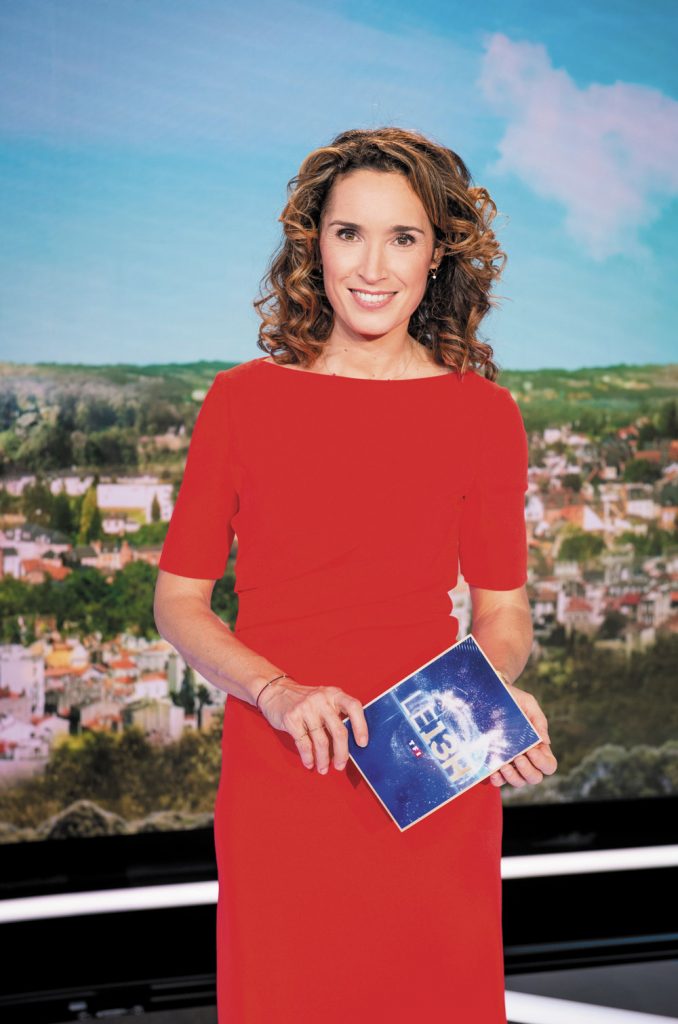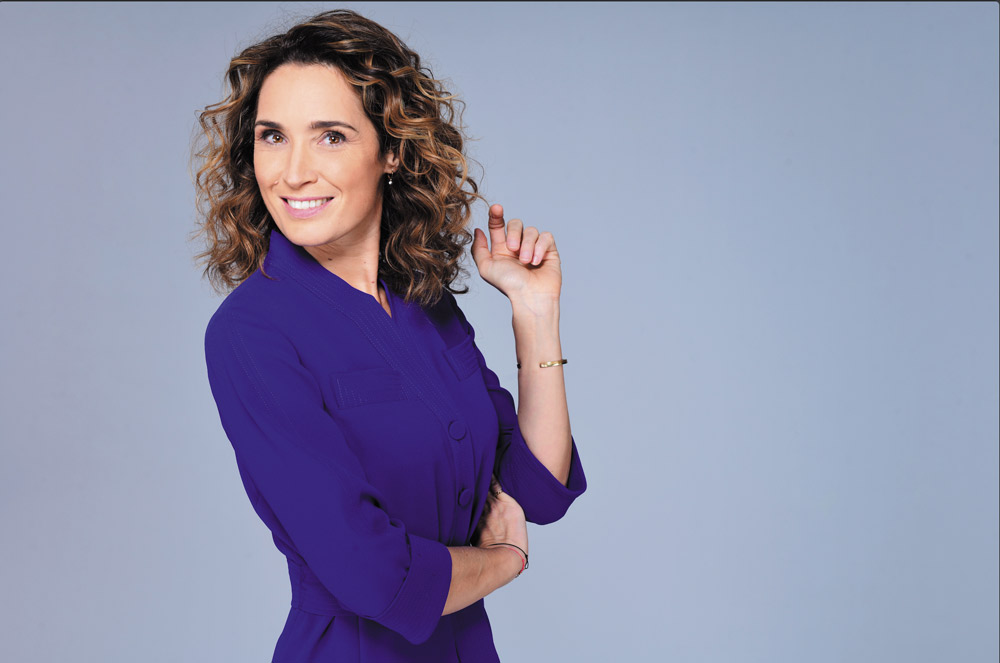The bubbly journalist and presenter of the 13h00 television news on TF1, Maria-Sophie Lacarrau confides in the readers of LiFE magazine about her passionate profession, her ritual, her desires, for our greatest pleasure.
How would you define the 1 o’clock news bulletin you have been presenting for almost 2 years now? How did you get to grips with things?
The 1 o’clock news is all about life and opinion. Our priority is to take the day’s news and choose the news that best reflects the lives of our viewers. Their everyday preoccupations, how things are evolving and changing. We go out to get their opinions, remarks, reactions, their expectations, frustrations and their incomprehension. We want to give those who don’t usually have the opportunity to do so to speak out. It’s about bottom-up information coming from different regions and even the smallest of villages in France rather than the decision-makers, accompanied by, whenever possible, a touch of optimism. This really is important for me and something I wanted to encourage when I took over. To find solutions and initiatives rather than problems. Our viewers tell us this. They are fed up with anxiety-inducing news. So yes, we present the news but at the same time try to see the glass as half full. This is our approach for the 1 o’clock news with new weekly features such as La bonne idée (A good idea), Les talents de nos regions (Regional talents), etc. When I took over one and a half years ago, my first decision was to maintain the editorial policy in place because it corresponds perfectly to who I am, to my values, my origins and love for the regions of France.
You’re not directly in contact with your audience so how do you maintain a relationship with them?
The initial contact I have with the viewers is through the news, so when I prepare the programme, when I think it over and choose, along with my team, the news we want to present, and when I write it all up in my office, I try to speak to them directly. With the intros, I want to catch their attention, to question them, to surprise them and have them react. This is very important for me. A bit like having a conversation with them. Then, during the news programme as such, we look to develop the interaction. We offer them the opportunity to write to us. We have a number of email addresses: le13havoscotés@tf1.fr, labonneidee@tf1.fr, le13haujardin@tf1.fr . We get a lot of messages that feed our reflexion and sometimes even become subjects that are given airtime and which we react to live. This is this year’s latest feature with our journalist Thierry Coiffier. Each day he joins me on the set to talk about an everyday problem that concerns one of our viewers. For example:
«I ordered a new car 6 months ago and it still hasn’t been delivered. What can I do?» «My neighbour rents out his house or flat via AirBnb. Every evening there is a lot of noise. What can I do?». We propose a news service. We accompany the people who watch us and provide concrete solutions. What is more, over and above this on-air connection, I also get loads of letters addressed directly to the TF1 studios that I reply to. I also like taking viewers backstage via social media to show how things work on an everyday basis. And finally, I sometimes attend meetings with readers of local regional media. So as you can see, I don’t live in a sort of protective bubble. Even though I am not a grass-roots journalist, I do maintain ties with the outside world and everyday life.

Has the way people see you changed since you took over?
First off, when I took over the 1 o’clock news, I was surprised, and still am, to get letters from young viewers. Particularly young girls who told me how motivating it was for them to see me appointed to the position. In our news bulletin, we try to speak to all the different generations, the whole family. But to answer your question, on a daily basis, yes, more people recognise me in the streets. When I go shopping, take the subway, go for a walk or when I return to my native Occitania, the conversations are always warm and friendly. The remark I hear most is: «Carry on doing us good! Your news tells us what’s going on and also cheers us up. Thank you!». That really is encouraging for all of us, meaning every member of the news team!
Do you try and cultivate emotion during your news broadcast?
I’m not sure to understand what you mean by emotions but I can assure you I never go for sensationalism. Humour and spontaneity, yes! The 1 o’clock news is a time to laugh, something Etienne Carbonnier quickly spotted for Quotidien on TMC television! It’s a time to be enthusiastic and also to decry things, a time to show one’s irritation for a specific situation to move on, to helps situations improve.
What is your best on-air recollection?
My best on-air recollection is in fact quite recent. It’s the final of France’s most beautiful markets, a competition created by Jean-Pierre Pernaut and one I intend to keep running. It’s a fantastic operation that promotes the producers who provide us food and the wonderful atmosphere of the market places in France. It took place in Narbonne last June. The city’s Les Halles were crowned France’s most beautiful market. The news was recorded live there among the local inhabitants and traders. The energy and pleasure was palpable.
If you hadn’t become a journalist, what profession would you have liked to have?
Are you a woman of multiple passions?
Becoming a journalist was always my priority, as early as junior-high school. If I hadn’t succeeded, I would have liked to be a proof-reader, reading and correcting manuscripts day in day out. I have to admit that I love spelling, grammar and conjugation, the rules and exceptions and synonyms to avoid repetition and so on. The richness and diversity of the French language is amazing and I simply love trying to respect it.
Which famous person do you dream of interviewing?
I really would have liked to have met Mother Teresa and the Abbé Pierre. I sincerely admire people who devote their entire lives to others. Self-sacrifice to such an extent is truly impressive. I would have loved to hear them explain to me how they managed to forget themselves and prevail despite the extremely difficult living conditions simply to help others who had nothing. Otherwise, quite frankly, from all the interviews I have already had, those that left the strongest mark were with anonymous people who accepted to talk and testify despite the difficulty and about extremely sensitive subjects such as domestic violence or the loss of a child.
With such a busy schedule, how do you manage to have a good work-life balance?
It’s true my days are pretty busy, but I can’t complain. I’m lucky, I’m living my dream. Unlike many other people, my working conditions are excellent. You talk about professional life and personal life and you are right, my family means everything to me. So, just like all the other parents, I juggle between the two and work two days each day. When I get home, I focus 100% on my children and husband. When I leave the office late afternoon, I do like other working parents: shopping, homework, cooking, and so on. I’m also lucky not to work weekends and can make the most of them with friends and family.
Take us through a typical day in the life of Marie-Sophie Lacarrau? Do you think we could keep up!
Of course you could! I’ve already said this but many other people have it much harder than me. The alarm goes off at 6am and I get to the office at 7.30 where my team is already waiting. Together we decide on the subjects to present. We have to go fast to give the team the time to get out filming before the editing, mixing and sending back to us. The 1 o’clock news is the first news bulletin of the day and we don’t have a minute to waste. You can almost feel the tension and I believe we all thrive on this! At 8.45 we have an editorial meeting with all the heads of department. I start writing the intros for each report around 10am. I come on set very late, just 3 or 4 minutes before the jingle. Now don’t start thinking that’s it for the day! We begin discussing the following day’s news and the days after that. We select the features, the long-running reports and delegate to our reporters. I get back home around 5.30pm or 6pm and that’s when the homework starts. At week-ends I take time out for a bit of yoga. I’ve been doing ashtanga and vinyasa yoga which are both fairly dynamic forms of yoga for 15 years now. This also helps in balancing my life and has become a vital part of my life too.
What would you like to wish LiFE Magazine readers?
I hope Life Magazine readers are happy and optimistic. I hope they make the most of the good times with those they love. Together, let’s try and encourage positive initiatives and bravo to all those who offer their time to an association. Bravo also to all those volunteers who do what they can to help others! We need to realise we can all play a part, however small. Here, I’m thinking in particular about an association for which I am one of the ambassadors. «Un enfant par la main» makes it possible to sponsor a child in need. Just 25 or 30 Euros per month means the child can eat, go to school, get medical treatment if necessary and so on. My little god-daughter is 12, she lives in Senegal and has just started junior-high school. If we can do something, do it!



